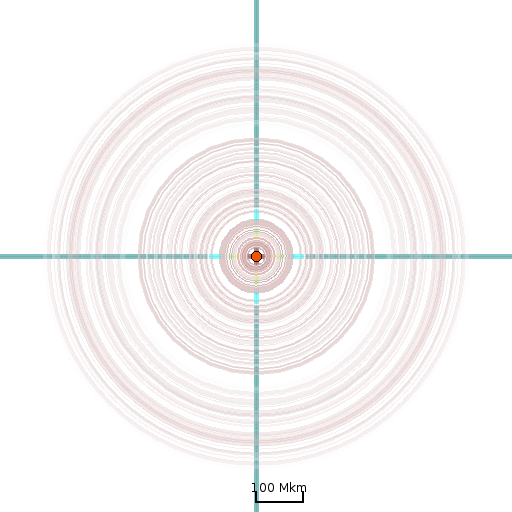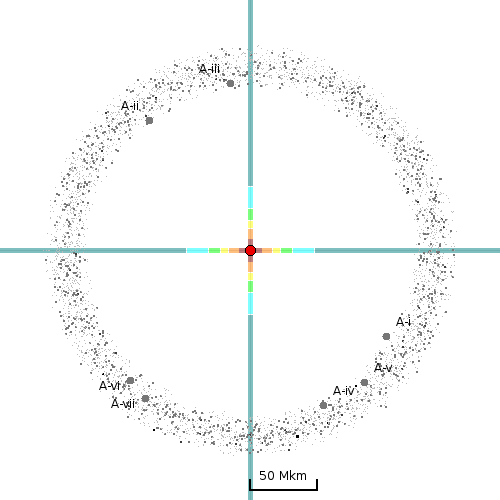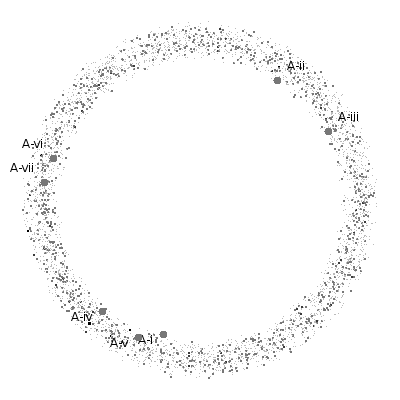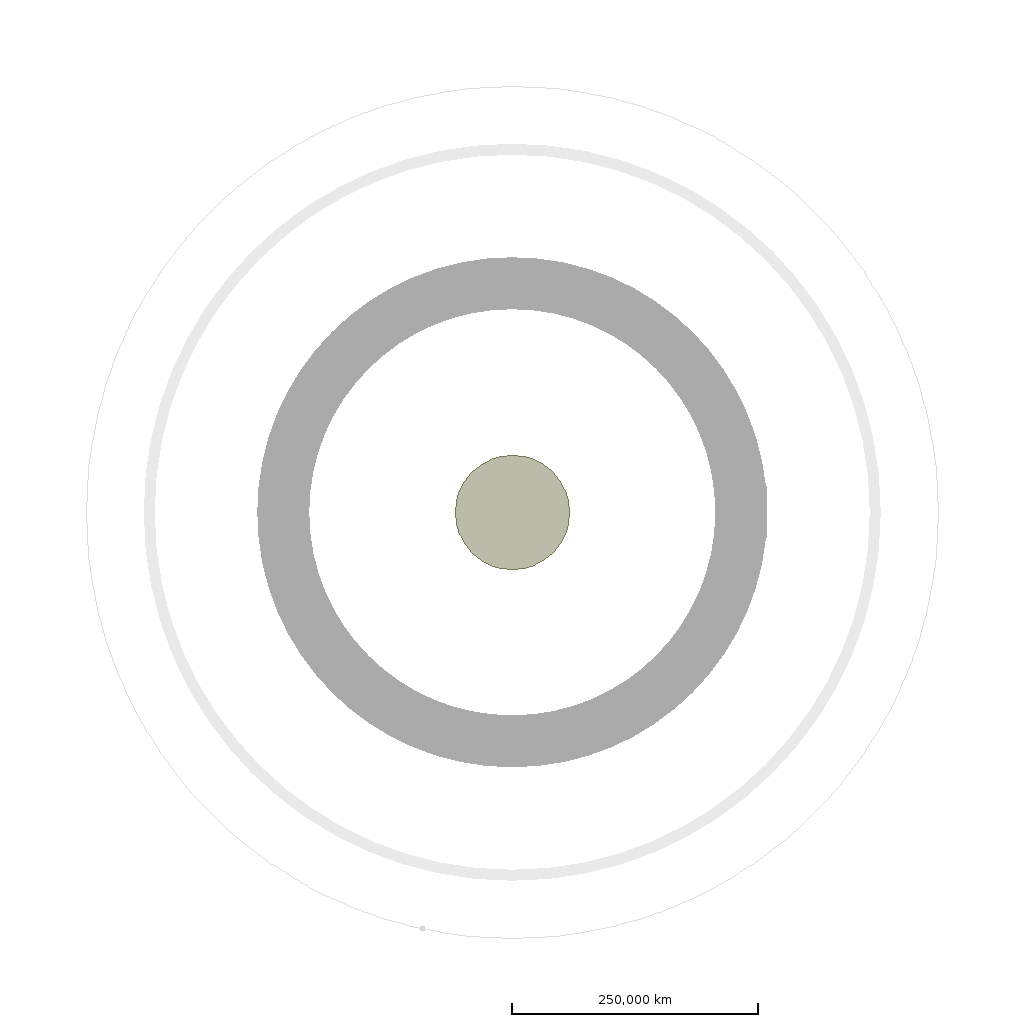The Belt Group

Out of all the different planet groups in the Planetary Classification Scheme that WorldGen uses, the Belt group is probably the most unusual, since none of its members are actually a planet, but a collection of minor objects. Some aren’t even that.
As such, mapping and creation is somewhat different to that of actual planets (which are roughly spheres), and depends on the type of object.
Note that all of these types are internally considered ‘planets’ by WorldGen. They have a type, distance (from star to midpoint), radius (width of the belt), density (relative number of objects) etc. This is simply to avoid having to create a different type of object in the database.
Circumstellar Class
The Circumstellar Class covers zones that encircle stars, either with clouds of dust and gas, or filled with chunks of rock. The density of such belts are always low, and it can be difficult to tell that you are in one without the use of sensitive scanner systems.
Dust Discs
A Dust Disc is a disc of dust or gas that surrounds a young star. The term ‘disc’ is probably a misnomer, since generally these clouds often take the form of toroids or shells that can completely enclose the star.
They consist of dust and gas left over from the formation of the star, and over time will either get blown away or start to coalesce into planets. However, they will rarely contain any planetoids themselves. Once proto-planets begin to form, then these will be shown as planets between multiple discs.
Dust Discs are displayed as sets of concentric rings, depicting the various densities within the belt. There will often be multiple discs within a star system, though this is mostly for implementation reasons – given how wide a disc can be, the temperate differences across its width can vary widely. Splitting it into multiple discs helps differentiate the different regions.

The density rings given an indication of the highest density of dust and gas, though it’s present throughout the disc. Even high density regions are pretty much vacuum however.
A dust ring does have a density value associated with it, though I haven’t decided what this should actually represent. I haven’t managed to find any good numbers for actual gas ring densities.
Planetisimal Disc
Similar to a Dust Disc, a Planetisimal Disc is made up of larger objects, though still on the millimetre to centimetre scale. Most of the gas has either been dispersed or has formed into solid particles, leaving behind solid matter.
There may be proto-planets in such a system, formed from the disc. Generally, a dust disc will form into a planetisimal disc over time, generally in the scale of millions of years.
Asteroid Belt
Asteroid Belts are probably what most people think of when a ‘belt’ is mentioned. They consist of large chunks of rock, some of which can be hundreds of kilometres in diameter. They are often formed after the collision of two large objects. As such, they are not the sign of planetary formation but more planetary destruction.

Asteroid belts, since they consist of millions of discrete objects, are displayed using a pseudo-random generator which allows the position of each ‘rock’ and major planetoid to be shown according to the current time.

Objects closer to the star orbit faster than those further from the star, so it’s not possible to simply create a map of the belt and rotate that as a single object.
We don’t store the position of each object, but use procedural generation to randomly generate each object in the right position according to the current simulation time. At low resolutions only the largest objects are shown, at higher resolutions more of the smaller objects are displayed.
As with everything in WorldGen, all asteroid orbits are perfectly circular.
Planetoids
An Asteroid Belt may contain one or more ‘planetoids’. These are treated internally as Moons, but they directly orbit the star. They represent the largest objects within the belt, and will often belong to the Small Body Group. Note that all the undefined objects in the Belt are assumed to belong to the Small Body Group, but most of them are small.
Note that apart from the named planetoids, there is no way to get information on individual objects within the belt – they are generated entirely for the purposes of the image.
Vulcanian Belt
A Vulcanian Belt is an an asteroid belt that has a large proportion of heavy metals. Often found close to a star, they are often hot and difficult to mine. There’s not much difference between a Vulcanian Belt and a plain Asteroid Belt, except in the type of resources that are likely to be found there – a higher proportion of heavy metals and radioactive materials.
Metallic Belt
An even more extreme version of a Vulcanian Belt, a Metallic Belt is quite rare. They almost entirely consist of actual metals – iron and other elements, and may be rich in elements such as gold and uranium. They are only found in high metallicity star systems.
Ice Belt
Ice Belts are found in the outer reaches of a star system, beyond the snow line. Like an asteroid belt, they consist of discrete objects that orbit in a large zone around the star. Since they tend to be more distant, the volume covered tends to be far more extensive, and the gaps between individual objects far more immense. In our solar system, the Kuiper Belt would be an Ice Belt.
Objects within an Ice Belt tend to be ices and other light volatiles, the sort of materials which would boil away closer to the star. Whilst asteroid belts tend to be the results of the destruction of larger bodies, an Ice Belt can be made of left overs from the formation of the solar system.
As for an Asteroid Belt, ice belts can have planetoids which will generally be of the Small Body Group, though often of the Cometary Class which are cold, icy bodies made up of frozen volatiles.
Ice Belts can be many AU wide.
Oort Cloud
Oort Clouds are the extreme version of an Ice Belt, and are found thousands of AU from a star, and can possibly be tens of thousands of AU in width. I haven’t yet decided how to model an Oort Cloud in WorldGen. They may simply be an attribute on a star system rather than an actual ‘planetary object’. However, they haven’t been implemented yet.
Planetary Ring Class
A Planetary Ring is, rather unsurprisingly, a ring around a planet. Similar to Circumsteller Belts, a planetary ring is considered a collection of smaller objects which aren’t individually tracked. Though they are most often found around gas giants, they can exist around smaller terrestrial worlds as well.

Unlike Belts, Rings do not have planetoids associated with them. It is assumed that any planetoids are moons of the parent planet, and will exist between multiple rings. Generally, due to the much smaller size of rings compared to belts, a moon will be able to clear its own orbit around the planet.

The planetary map will show the position of the ring relative to the rest of the planetary system, including the other rings and any moons.
Dust Ring
A Dust Ring is a ring of small non-volatile dust particles, generally on the millimetre size. They may be left over after a collision, but are more likely to have been ejected from a volcanic eruption from a moon. They can be quite rare.
Ice Ring
An Ice Ring is the most common type of ring to be found around planets, and are most often found around Jovian worlds beyond the snow line. They are often the result of a collision between two or more icy moons.
They will consist of icy volatiles up to a few metres in diameter, but most will be much smaller.
The thickness of a ring will usually be on the order of metres to tens of metres, though some can be as much as a kilometre in thickness.
Rock Ring
A Rock Ring is similar to an Ice Ring, except that they are formed from heavier non-volatile elements, such as silicates or carbon compounds. They are often formed after the collision of rocky moons, or even after a large asteroid impact on the planet’s surface. In theory it would be possible to find a molten ring of material formed immediately after such a collision, but they so quickly cool down that none have ever been discovered.